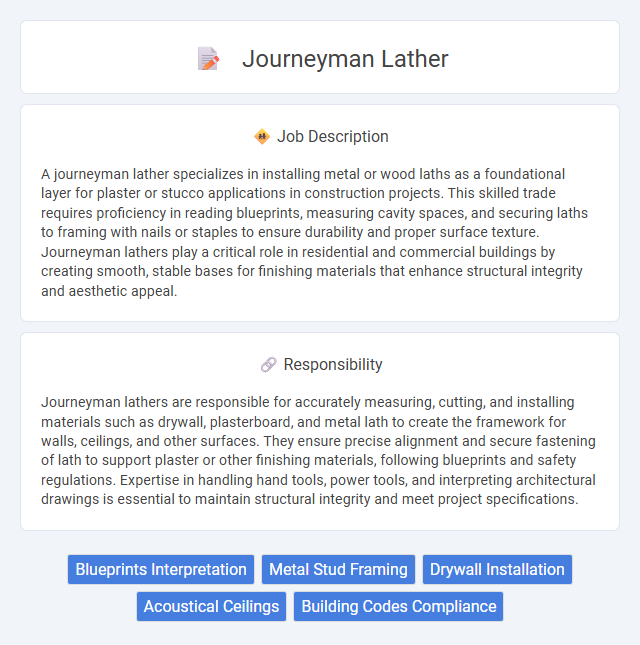
A journeyman lather specializes in installing metal or wood laths as a foundational layer for plaster or stucco applications in construction projects. This skilled trade requires proficiency in reading blueprints, measuring cavity spaces, and securing laths to framing with nails or staples to ensure durability and proper surface texture. Journeyman lathers play a critical role in residential and commercial buildings by creating smooth, stable bases for finishing materials that enhance structural integrity and aesthetic appeal.
Individuals with strong physical stamina and good hand-eye coordination are likely to be suitable for a journeyman lather job, as the work involves precise measurements and handling heavy materials. Those who can tolerate working in various weather conditions and have an attention to detail may find the role more manageable and rewarding. Conversely, people with limited physical endurance or difficulty working at heights might face challenges performing effectively in this profession.
Qualification
A Journeyman lather must possess a combination of technical skills and formal training, typically completed through a four-year apprenticeship program including classroom instruction and paid on-the-job experience. Mastery of measuring, cutting, and installing metal lath and plaster systems is essential, alongside knowledge of safety regulations and blueprint reading. Certification from a recognized trade organization enhances job prospects and validates proficiency in advanced lathing techniques.
Responsibility
Journeyman lathers are responsible for accurately measuring, cutting, and installing materials such as drywall, plasterboard, and metal lath to create the framework for walls, ceilings, and other surfaces. They ensure precise alignment and secure fastening of lath to support plaster or other finishing materials, following blueprints and safety regulations. Expertise in handling hand tools, power tools, and interpreting architectural drawings is essential to maintain structural integrity and meet project specifications.
Benefit
A journeyman lather job likely offers the benefit of steady employment in the construction industry, with opportunities for skill development and career advancement. Workers in this role may experience competitive wages and potential health and retirement benefits through union membership. This job could provide valuable experience that increases future job security and earning potential.
Challenge
The journeyman lather job likely involves complex challenges such as mastering the precise installation of metal frameworks that support plaster or drywall, which requires both skill and attention to detail. Navigating tight schedules and coordinating with other trades may pose probabilities of time management difficulties. Problem-solving skills are probably essential to handle unexpected site conditions and material inconsistencies efficiently.
Career Advancement
Journeyman lathers build expertise in installing metal frameworks for drywall and ceilings, mastering blueprint reading and various fastening techniques. Advancing in this trade typically involves gaining certifications, developing supervisory skills, and transitioning into roles such as lead lather or project manager. Strong proficiency in safety regulations and material knowledge enhances opportunities for higher-paying positions within construction and specialty contracting firms.
Key Terms
Blueprints Interpretation
Journeyman lathers specialize in interpreting detailed blueprints to accurately measure, cut, and install metal lath systems for construction projects. Mastery in blueprint reading ensures precise alignment and structural integrity when preparing surfaces for plaster or stucco application. Expertise in deciphering complex diagrams enhances efficiency and reduces material waste during the framing and lath installation process.
Metal Stud Framing
Journeyman lathers specialize in installing metal stud framing, a critical component in modern commercial and residential drywall systems. They precisely measure, cut, and assemble metal studs to create durable frameworks that support drywall panels and ensure structural integrity. Proficiency in reading blueprints and using power tools enhances efficiency and accuracy in metal stud framing projects.
Drywall Installation
Journeyman lathers specialize in drywall installation, expertly measuring, cutting, and fastening drywall panels to walls and ceilings for seamless surface preparation. They apply tape and joint compound to create smooth finishes, ensuring durability and aesthetic quality. Proficiency in using hand tools, power tools, and safety equipment is essential for efficient and precise drywall installation.
Acoustical Ceilings
Journeyman lathers specializing in acoustical ceilings install, repair, and maintain ceiling systems designed to enhance sound absorption and improve acoustic performance in commercial and residential spaces. They work with materials such as mineral fiber panels, fiberglass, and metal grids, ensuring precise fit and finish to meet building codes and safety standards. Expertise in reading blueprints, handling suspension systems, and applying soundproofing techniques is crucial for achieving optimal noise control and aesthetic appeal.
Building Codes Compliance
Journeyman lathers ensure the installation of metal or wood frameworks for drywall and ceilings aligns strictly with local building codes and safety standards. Their expertise in measuring and constructing lath systems guarantees structural integrity and compliance during inspections. Maintaining up-to-date knowledge of national and regional building regulations helps prevent costly violations and promotes workplace safety.
 kuljobs.com
kuljobs.com